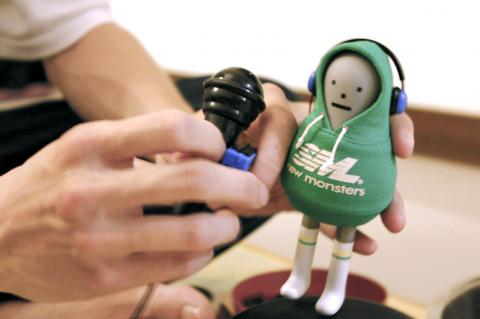Following last year’s Earth Project I (土地計畫首部曲), which explores issues surrounding land use and environmental justice, Short One Player Theater (三缺一劇團) returns with The Story of Keelung (海港山城藝術季), a mini art festival taking place in Keelung this weekend.
Since 2013, the troupe has performed in Taipei, but this year, their sights are set on the once-thriving harbor city. The festival will feature three short performances by young artists that explore the harbor city’s past and present.
The choice of venue — a five-story building belonging to a troupe member’s family that also served as a dental clinic between the 1970s and 1990s — is rather unusual. The house has been vacant for years, with many objects and wares left inside, says director Flower Lee (李玉嵐).

Photo courtesy of Short One Player
The furniture and layout of the rooms remain unchanged in The Forsaken (遺棄之時) — one of the performances taking place on the weekend. Choreographer Yu Yen-fang (余彥芳) says the idea behind the storyline comes from Yu’s impression of Keelung being frozen in time — just like the deserted house.
Tao Wei-chun (陶維均), the director of Second Hand (二手), had a similar idea when he used objects in the rooms as props to tell a story about Keelung’s laborers.
The last performance, A Blurry Keelung (模糊的基隆), revolves around a suicidal woman talking to voices in her head. It is staged by In Troupe (影劇坊), another theatrical group consisting of 20-somethings.
“When watching [In Troupe’s] work, I get a very strong feeling of being trapped. I think these youngsters have conveyed how it feels [living in Keelung] through their performance,” Lee says.
“Young people have to go to Taipei to find jobs and work. But they also want to do something for Keelung — otherwise they wouldn’t set up a theatrical group here,” she adds.
But things are changing for the better. Lee says local youth have been engaging in cultural activities to understand their hometown more and also to improve the lives of those living there.
For example, Keelung Rain (雞籠霧雨), a non-profit set up last year, focuses on the people and history Keelung.
Moreover, in March, Keelung Youth Front (基隆青年陣線), a community development organization, held an art fair at a deserted historic house after spending several months cleaning it up.
Lee says the possibilities are limitless.
“We have been here for three years and are starting to understand it a little bit. Hopefully, the festival can stay for several more years as a platform to connect with local artists, cultural workers and groups,” she says.
All three performances are 20 minutes and performed at different floors of the house. Audiences will be divided into groups, taking turns to watch the shows. For more information, visit www.facebook.com/shortoneplayertheater.

In the March 9 edition of the Taipei Times a piece by Ninon Godefroy ran with the headine “The quiet, gentle rhythm of Taiwan.” It started with the line “Taiwan is a small, humble place. There is no Eiffel Tower, no pyramids — no singular attraction that draws the world’s attention.” I laughed out loud at that. This was out of no disrespect for the author or the piece, which made some interesting analogies and good points about how both Din Tai Fung’s and Taiwan Semiconductor Manufacturing Co’s (TSMC, 台積電) meticulous attention to detail and quality are not quite up to

April 21 to April 27 Hsieh Er’s (謝娥) political fortunes were rising fast after she got out of jail and joined the Chinese Nationalist Party (KMT) in December 1945. Not only did she hold key positions in various committees, she was elected the only woman on the Taipei City Council and headed to Nanjing in 1946 as the sole Taiwanese female representative to the National Constituent Assembly. With the support of first lady Soong May-ling (宋美齡), she started the Taipei Women’s Association and Taiwan Provincial Women’s Association, where she

Chinese Nationalist Party (KMT) Chairman Eric Chu (朱立倫) hatched a bold plan to charge forward and seize the initiative when he held a protest in front of the Taipei City Prosecutors’ Office. Though risky, because illegal, its success would help tackle at least six problems facing both himself and the KMT. What he did not see coming was Taipei Mayor Chiang Wan-an (將萬安) tripping him up out of the gate. In spite of Chu being the most consequential and successful KMT chairman since the early 2010s — arguably saving the party from financial ruin and restoring its electoral viability —

It is one of the more remarkable facts of Taiwan history that it was never occupied or claimed by any of the numerous kingdoms of southern China — Han or otherwise — that lay just across the water from it. None of their brilliant ministers ever discovered that Taiwan was a “core interest” of the state whose annexation was “inevitable.” As Paul Kua notes in an excellent monograph laying out how the Portuguese gave Taiwan the name “Formosa,” the first Europeans to express an interest in occupying Taiwan were the Spanish. Tonio Andrade in his seminal work, How Taiwan Became Chinese,